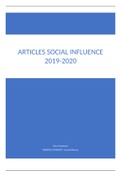ARTICLES SOCIAL INFLUENCE
2019-2020
Eline Meuleman
RADBOUD UNIVERSITY Social influence
,Reciprocity
Goei, R., Roberto, A., Meyer, G., & Carlyle, K. (2007). The Effects of Favor and Apology on Compliance.
Communication Research, 34(6), 575–595. http://doi.org/10.1177/0093650207307896
Goldstein, Griskevicius, & Cialdini, 2011. Reciprocity by proxy: A novel influence strategy for
stimulating cooperation. Administrative Science Quarterly, 56, 441-473.
Commitment and consistency
Aronson, E. (1999). The power of self-persuasion. American Psychologist, 54(11), 875.
Cialdini, R. B., Wosinska, W., Barrett, D. W., Butner, J., & Gornik-Durose, M. (1999). Compliance with a request
in two cultures: The differential influence of social proof and commitment/consistency on collectivists and
individualists. Personality and Social Psychology
Bulletin, 25(10), 1242-1253.
Müller, B., van Someren, D. H., Gloudemans, R. T. M., Van Leeuwen, M. L., & Greifeneder, R. (2017). Helping
made easy: Ease of Argument Generation Enhances Intentions to Help. Social Psychology, 48, 113-121
Sociaal proof
Griskevicius, V., Goldstein, N. J., Mortensen, C. R., Sundie, J. M., Cialdini, R. B., & Kenrick, D. T. (2009). Fear and
loving in Las Vegas: Evolution, emotion, and persuasion. Journal of Marketing Research, 46(3), 384-395.
Liking & Scarcity
Burger, J. M., Messian, N., Patel, S., Del Prado, A., & Anderson, C. (2004). What a coincidence! The effects of
incidental similarity on compliance. Personality and Social Psychology Bulletin, 30(1), 35-43.
Van Leeuwen, M. L., & Neil Macrae, C. (2004). Is beautiful always good? Implicit benefits of facial
attractiveness. Social cognition, 22(6), 637-649.
Social influence in organizations
Treadway, D. C., Breland, J. W., Williams, L. M., Cho, J., Yang, J., & Ferris, G. R. (2013). Social influence and
interpersonal power in organizations: Roles of performance and political skill in two studies. Journal of
Management, 39(6), 1529-1553.
Unconscious influence
Loersch, C., & Payne, B. K. (2011). The situated inference model: An integrative account of the effects of primes
on perception, behavior, and motivation. Perspectives on Psychological Science, 6(3), 234-252.
Authority
Doliński, D., Grzyb, T., Folwarczny, M., Grzybała, P., Krzyszycha, K., Martynowska, K., & Trojanowski, J. (2017).
Would you deliver an electric shock in 2015? Obedience in the experimental paradigm developed by Stanley
Milgram in the 50 years following the original studies. Social psychological and personality science, 8(8), 927-
933.
Damen, T. G., van Leeuwen, M. L., Dijksterhuis, A., & van Baaren, R. B. (2014). Authority defied: need for
cognitive closure influences regulatory control when resisting authority. Journal of personality, 82(4), 310-316.
1
,Content
The Effects of Favor and Apology on Compliance (Goei, 2007)..............................................................3
Reciprocity by proxy: A novel influence strategy for stimulating cooperation (Goldstein, 2011)...........5
The power of self-persuasion (Aronson, 1999).....................................................................................12
Compliance with a request in two cultures: The differential influence of social proof and
commitment/consistency on collectivists and individualists (Cialdini, 1999).......................................14
Helping made easy: Ease of argument generation enhances intentions to help (Müller, 2017)..........16
Fear and loving in Las Vegas: Evolution, emotion and persuasion (Griskevicius, 2009).......................18
What a coincidence! The effects of incidental similarity on compliance (Burger, 2004)......................20
Is beautiful always good? Implicit benefits of facial attractiveness (van Leeuwen, 2004)....................22
Social influence and interpersonal power in organizations: Roles of performance and political skill in
two studies (Treadway, 2013)..............................................................................................................23
The situated inference model: an integrative account of the effects of primes on perception, behavior
and motivation (Loersch, 2011)............................................................................................................25
Would you deliver an electric shock in 2015? Obedience in the experimental paradigm developed by
Stanley Milgram in the 50 years following the original studies (Dolinski, 2017)...................................29
Authority defied: need for cognitive closure influences regulatory control when resisting authority
(Damen, 2014)......................................................................................................................................30
2
, The Effects of Favor and Apology on Compliance (Goei, 2007)
Abstract: This study was designed to test the effects of favor and apology on compliance and to
explain any potential effect via indebtedness, gratitude, and liking. Two experiments were devised to
accomplish these ends. In the first experiment favor and apology were varied in the absence of a
transgression to see if apologizing for not providing a favor can be used proactively to increase
compliance. In the second experiment favor and apology were varied in a more common scenario,
following a transgression. Results show that favor has a positive effect on compliance mediated by
gratitude when using a general prosocial request and by liking when using a more altruistic request.
Results also suggest that apology has a positive effect on liking and that apology has an indirect effect
on compliance under certain conditions.
Background
A way to increase compliance is to provide a favour or apology to a target before making a
direct request for compliance.
Favor increases compliance. Strongest effect when it occurs between strangers.
The most commonly accepted explanation for the favor–compliance relationship is that the
norm of reciprocity mandates the reciprocation of favors. Upon the receipt of a favor,
internalization of the norm of reciprocity induces a psychological state of indebtedness or
obligation.
When predicaments arise and project unwanted, negative aspersions on our character, an
apology is one method of remediation.
First experiment (apologizing for not providing an unsolicited favor):
A confederate and participant filled in a lot of questionnaires.
The confederate walked away after a while, and then he returned back with..
o No favor/ no apology: confederates returned to their seat without saying anything
o No favor/ apology: only water for him selve + apologizing for that
o Favor/ no apology: bringing water for the participant
o Favor / apology: first not bringing water, than apologizing and buying a new bottle of
water for the participant
Results:
o Apology increases liking and indebtedness, gratitude and liking all increase
compliance
o Favour increased indebtedness, gratitude
o Favor Gratitude Compliance
Second experiment (apology following a transgression):
During a silent experiment, the confederate got called. In the apology condition, the
confederate turned around and apologize.
Some time later, the confederate either got one (no favor) or two (favor) bottles of water.
Results:
o Favor has an effect on indebtedness, gratitude and liking
o Liking has an effect on compliance
3




